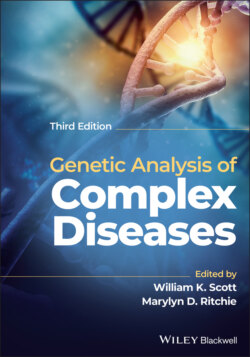Читать книгу Genetic Analysis of Complex Disease - Группа авторов - Страница 15
Clinical Definition
ОглавлениеIt is not enough to define a trait in binary terms, such as the presence or absence of Huntington’s disease or diabetes. In Huntington’s disease, for example, there can be wide variation in the symptoms, with some only psychological or very mild motor disturbances detectable by expert examination, and the age at which these symptoms begin is similarly variable. In diabetes, there are distinct subtypes (insulin‐dependent diabetes mellitus and non‐insulin‐dependent diabetes mellitus) as well as variable age at onset. Additionally, blood glucose levels (a quantitative trait) are strongly associated with diabetes (a qualitative trait) and could be used as a surrogate measure or endophenotype. One critical role of the clinician in study design is to assess the various diagnostic procedures and tools and determine which ones best define a consistent phenotype. Additionally, dissecting genetically complex diseases usually requires large datasets to supply enough power to unravel genetic effects. For this reason, participant ascertainment often extends to multiple sites. It is critical for multi‐site studies to establish consensus diagnostic procedures and criteria and apply them consistently across sites. For example, the establishment of a consensus diagnostic scheme (McKhann et al. 1984) played an important role in a successful complex disease linkage study in late‐onset familial Alzheimer’s disease (Pericak‐Vance et al. 1991) and subsequent identification of the association of Alzheimer’s disease and common variation in the APOE gene (Corder et al. 1993; Corder et al. 1994).
The phenotype assignment must be done in a rigorously consistent fashion. Even a small rate of phenotype error might alter analytic results – in some cases leading to false‐positive results and in others to false‐negative results. Thus, which data will be used to assign the trait status must be carefully determined. Must detailed clinical records of an examination specifically addressing the phenotype be obtained and reviewed for consistency on every participant? Is the self‐report of a participant or a participant’s relative sufficient? Is a note documenting a diagnosis (but no examination findings) from a medical record adequate? Or is direct examination of every participant using a standardized research protocol required? Additionally, investigators must consider whether to collect additional biomarker data (e.g. antibody titers, protein assays) or clinical tests (e.g. electroencephalogram, electrocardiogram, magnetic resonance imaging) that might correlate with the trait of interest. The goal of the phenotyping protocol is to standardize procedures, minimize error in determining the phenotype, and maximize the power of the dataset to detect genes underlying the trait.
